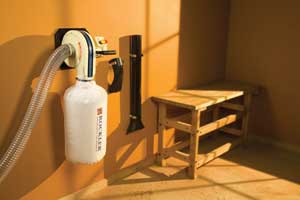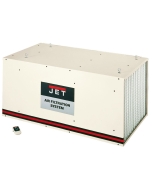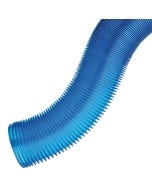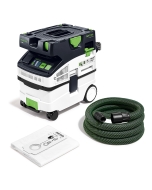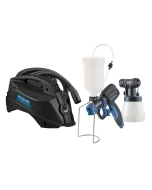Dust and Air Movement in the Shop
I am in the final stages of building a new workshop and am undecided about how best to deal with dust abatement. My shop is a relatively small 20' x 25', which includes an 8' x 10' finishing room. Locating a good dust collection system inside the shop would not only take up valuable space, but would, to some degree, reintroduce some particulates back into the shop environment. Since I live in a rural area, my first impulse is to locate a single-stage collector outside. In the summer, I would have windows open at the opposite end of the shop, but in the winter I am concerned about the negative pressure differential in the shop when the vacuum is turned on and the wood stove is operating. It seems like smoke would be drawn into the shop which, of course, would be unacceptable. What do you recommend? - Phil Myers
Rob Johnstone: Dust control is best done in three ways: the first is at the point of the dust source. Tools like handheld sanders, jigsaws, routers, etc., all create dust and chips portable vacuum attached to them - which is a very good idea. Second, there are the stationary tools like band saws, table saws, jointers and the like. There, in a small shop like yours, a portable dust collector is a very good solution, as you can roll it around to each tool as needed, and store it against the wall when you don't. Rockler has a wall-mounted unit, that you can connect a long hose to, that might do the trick as well, as you have indicated that your shop is smallish. The third leg to the dust collection triangle is an ambient air filter. All of the previously mentioned dust extraction approaches miss some dust and particulate. The ambient air filter takes care of that airborne dust. My recommendation is that you get to the three-tiered solution as you can afford it. I would start with the shop-vac approach, then add the dust collector and finish with the ambient air filter.
Tim Inman: You're very wise to consider air movement issues in your shop. Negative air pressure is a constant issue for finishers - especially those fortunate enough to use a spray booth. You will, indeed, "suck" smoke back into your shop if you have enough power in your vacuum system. "Make-up" air is the solution. Providing a source for fresh, clean, hopefully heated, "make-up" air is the best answer. This can be something as simple as an opened window or door, or a dryer vent installed without the little damper paddle so air can move into your room, then on to something as complex as a full-blown make-up air unit. A make-up air unit is a positive air pressure piece of HVLP equipment. They are common in commercial settings, but almost never seen in a hobby shop (read "expensive"). Whatever you do, be sure you return clean fresh air to your shop to compensate for the air drawn out by the vac system.
Chris Marshall: Aside from the wood stove aspect of your setup, my shop seems quite similar to yours. I have a single-stage dust collector located separately from my shop space to help eliminate the extra noise and dust. I also heat my shop with a furnace that burns propane. The furnace has a power exhaust fan to help prevent any back drafting from occurring, but I just leave the door open a tad when I'm running the collector to prevent a negative air pressure situation. And, I only run the dust collector when I'm using a machine that requires it. I've never had a problem with furnace exhaust building up in the shop as a result of running the dust collector. Just to be on the safe side, I also have a carbon monoxide detector plugged in to give me plenty of early warning. I've really appreciated having the dust collector in a separate room — and I bet you will, too! Good luck with your new shop.
Keep the inspiration coming!
Subscribe to our newsletter for more woodworking tips and tricks
